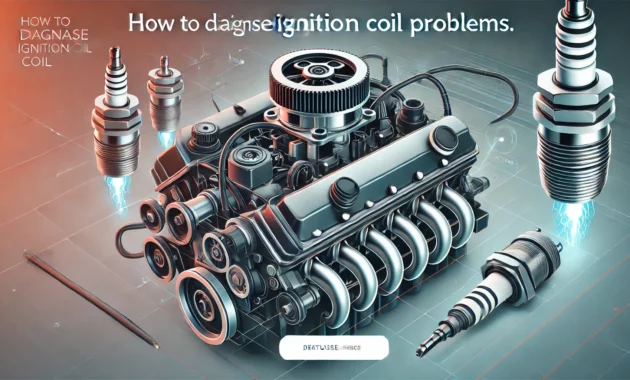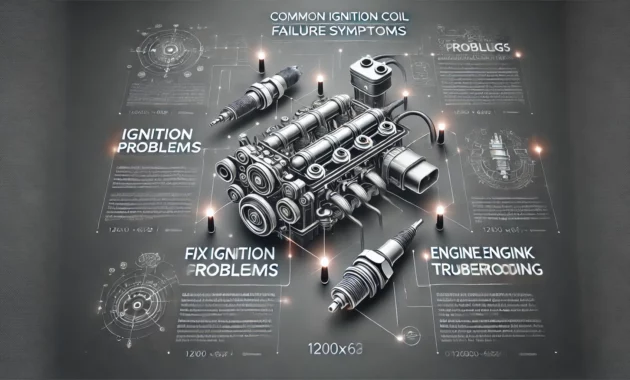
The spark plug coil, or ignition coil, is a crucial part of your vehicle’s ignition system. If it fails, it can lead to serious engine performance issues, such as misfires, stalling, and poor fuel efficiency. Fortunately, many ignition coil problems are diagnosable and fixable with some basic troubleshooting techniques. Let’s dive into how to identify a faulty ignition coil, the common symptoms of failure, and how to test the ignition coil resistance.
How to Diagnose a Faulty Ignition Coil
Diagnosing a faulty ignition coil is an essential step in troubleshooting engine performance issues. A bad ignition coil can cause engine misfires, poor acceleration, or stalling. Here’s how to diagnose a problematic coil:
- Check for Engine Misfires: The most common sign of a faulty ignition coil is engine misfires. If you notice a rough idle or your car jerks when accelerating, the coil could be failing to send a proper spark to the spark plug.
- Listen for Odd Engine Sounds: When an ignition coil malfunctions, it can lead to backfiring or a rough-running engine. If you hear a popping noise from the exhaust, it’s a sign that the engine is misfiring due to a weak spark.
- Examine the Spark Plugs: Remove the spark plug wires and check the spark plugs for wear or damage. If they appear fouled or burnt, it could indicate an issue with the ignition coil.
- Check for a Check Engine Light: A faulty ignition coil is likely to trigger the Check Engine Light (CEL). You can use an OBD-II scanner to pull the error codes. Common codes like P0301 (cylinder misfire) often indicate an ignition coil issue.
- Perform a Visual Inspection: Look for visible signs of damage on the ignition coil, such as cracks, burns, or carbon tracking. Damage to the coil housing can lead to poor performance.
Ignition Coil Issues Causing Engine Stalling
One of the more frustrating symptoms of a bad ignition coil is engine stalling. If the coil is failing, it can prevent the spark plug from firing at the right time, causing the engine to lose power or stall altogether. Here’s how ignition coil issues can cause engine stalling:
- Weak Spark: A faulty ignition coil can produce a weak spark, leading to incomplete combustion. This causes the engine to stall or struggle to maintain idle speed.
- Random Stalling: If the coil works intermittently, the engine may stall unexpectedly while driving or idling. This can be particularly dangerous because it may occur at any time, including while on the highway.
- Engine Starts, Then Dies: In some cases, a bad ignition coil might allow the engine to start but immediately stall after a few seconds. This happens when the coil cannot produce a consistent spark to keep the engine running.
If your car stalls while idling or driving, it’s time to check the ignition coil. It’s a good idea to inspect for damage or use a diagnostic tool to confirm if the coil is the culprit.
Engine Misfire Due to Ignition Coil Failure
An engine misfire is one of the most noticeable symptoms of an ignition coil failure. The misfire occurs when one or more cylinders fail to fire properly, leading to rough engine performance. Here’s how a malfunctioning ignition coil can lead to misfires:
- Incomplete Combustion: When the ignition coil doesn’t supply enough voltage to the spark plug, the spark plug won’t ignite the fuel mixture properly. This leads to incomplete combustion, resulting in a misfire.
- Jerking and Hesitation: You may notice your car jerking or hesitating during acceleration. This is due to the cylinder not firing at the correct time, causing a delay in power delivery.
- Poor Fuel Efficiency: Misfires caused by ignition coil failure can lead to increased fuel consumption. The engine is not running efficiently, causing it to burn more fuel than necessary.
If you notice any of these symptoms, it’s important to troubleshoot the ignition coil as a potential cause of the engine misfire.

Common Ignition Coil Failure Symptoms
When an ignition coil starts to fail, it can exhibit several symptoms that affect the overall performance of the vehicle. Here are the most common symptoms to watch for:
- Check Engine Light: As mentioned, the most obvious sign of a failing ignition coil is the Check Engine Light (CEL). The OBD-II system will register error codes like P0300, P0301, or similar, indicating a misfire or coil-related issue.
- Engine Misfires: A faulty ignition coil can cause the engine to misfire, leading to rough idling, jerking, and poor acceleration.
- Stalling and Hard Starting: If the coil is intermittently failing, the engine may have trouble starting or could stall while driving. The vehicle may start fine but stall after a few seconds or after a rough idle.
- Poor Acceleration: A weak spark due to a bad ignition coil can cause sluggish acceleration and a general lack of power when driving.
- Increased Fuel Consumption: Ignition coil failure can lead to incomplete combustion, which results in increased fuel consumption.
How to Test Ignition Coil Resistance
Testing the resistance of an ignition coil is a reliable way to determine if it’s functioning correctly. Here’s how you can test your ignition coil’s resistance:
Step-by-Step Guide to Testing Ignition Coil Resistance
- Preparation:
- Turn off the engine and remove the ignition coil from the vehicle. Ensure that the ignition is off, and the key is removed from the ignition.
- You’ll need a digital multimeter that can measure resistance (ohms).
- Test Primary Coil Resistance:
- Set your multimeter to measure resistance (Ω).
- Place one multimeter probe on the positive terminal of the ignition coil and the other probe on the negative terminal.
- Check the resistance reading against the manufacturer’s specifications (usually found in your car’s service manual). Typically, primary resistance ranges from 0.4 to 2 ohms.
- Test Secondary Coil Resistance:
- Move the probes to the high-voltage terminal of the coil and the ground terminal.
- The resistance should typically range between 6,000 and 12,000 ohms.
- If the resistance is outside the specified range, the coil is likely defective.
- Check for Continuity:
- A coil that has no continuity (an infinite resistance reading) is faulty and needs to be replaced.
Conclusion
Troubleshooting a faulty spark plug coil involves identifying common symptoms like engine misfires, stalling, and poor acceleration. By diagnosing the ignition coil properly and testing the coil’s resistance, you can pinpoint the issue and replace the faulty coil before it causes more serious engine problems.
If you’re noticing signs of a misfire, stalling, or poor performance, the ignition coil should be one of the first components to inspect. Regular maintenance, including testing the coil and replacing faulty components, will help ensure your vehicle runs smoothly for years to come.
FAQs: Spark Plug Coil Troubleshooting
- What are the most common symptoms of a faulty ignition coil?
The most common symptoms include engine misfires, rough idling, poor acceleration, and check engine light. You may also notice increased fuel consumption or engine stalling if the ignition coil is malfunctioning. - How do I know if my ignition coil is bad?
If your vehicle is experiencing engine misfires, rough idle, or poor acceleration, or if the check engine light is on, it could indicate a faulty ignition coil. A diagnostic scan tool can help identify trouble codes like P0300 or P0301, which typically point to ignition coil issues. - What causes an ignition coil to fail?
Ignition coils can fail due to electrical issues, heat exposure, excessive wear, or poor maintenance. Over time, the coil windings can degrade, leading to weak spark production or total failure. - Can I test the ignition coil myself?
Yes, you can test the ignition coil using a digital multimeter to measure primary and secondary resistance. If the readings fall outside the manufacturer’s recommended range, the coil is likely faulty and needs replacement. - How do I test the ignition coil resistance?
To test the resistance, set your multimeter to measure ohms (Ω). Test both the primary coil resistance (between the positive and negative terminals) and the secondary coil resistance (between the high-voltage terminal and ground). Compare the results with the recommended resistance values found in your vehicle’s manual. - What happens if I drive with a bad ignition coil?
Driving with a bad ignition coil can lead to engine misfires, poor performance, and increased fuel consumption. If left unaddressed, it can also cause further damage to the engine or other ignition components. - Can a faulty ignition coil cause engine stalling?
Yes, a bad ignition coil can cause engine stalling because it may fail to provide a consistent spark to the engine’s cylinders. This can result in a rough idle or the engine cutting off unexpectedly. - How long does an ignition coil typically last?
An ignition coil typically lasts between 50,000 to 100,000 miles. However, it may wear out faster if subjected to high engine temperatures or poor maintenance practices. It’s essential to replace faulty coils as soon as possible to avoid further engine issues. - Can I replace just one ignition coil if it fails?
Yes, you can replace a single faulty ignition coil, especially in a coil-on-plug system where each cylinder has its own coil. However, if several coils are showing signs of failure, it’s a good idea to replace them all for consistent performance. - Why does my engine misfire after I replaced the ignition coil?
If your engine continues to misfire after replacing the ignition coil, the issue might not be with the coil itself. You should check other components like the spark plugs, spark plug wires, or fuel injectors, as these can also cause misfires. A diagnostic scan can help pinpoint the exact problem.
